Starting your little one on solid foods is a very exciting step in the first year of their life! Finally, you get to introduce them to all the amazing flavors of this world, and meat baby food should also find its way onto the menu.
Meat baby food can be introduced very quickly after giving solids to your baby for the very first time.
This usually happens around the 6-month mark when babies are developed enough for this stage (can sit up on their own, control their head, etc.)
Considering that infants grow and develop at a rapid rate in the first year of their life, meat such as chicken, beef, and even fish, provides them with all the necessary nutrients they need to hit all of their milestones on time.
One of the most important nutrients in meat is iron, which babies need more of after they are 6 months old because the reserves of iron they’ve built up in their mom’s womb start to dry up.
So, keep reading to get an in-depth overview of why meat in baby food is important – I’ve also included super-easy recipes for you to try out as you enter this exciting new phase!
Meat Baby Food Tips And Recipes

But at a certain point, your little one is ready for solid foods.
A baby is usually ready for solid food between 4 to 6 months of age, but there are other signs to look out for that will indicate that she is ready for this next feeding step.
For example, your baby can already sit on her own, with or without support, and is able to control her head.
When you put a bit of food in a spoon and bring it to her mouth, she opens her mouth and moves closer, indicating that she would like to eat.
On the other hand, no other food apart from breast milk or formula should be given to babies before they are 4 months old, as this can lead to different health issues, most notably obesity and excessive weight gain.
What’s more, some of the food might find its way inside the baby’s airways, which is very dangerous.
It’s also important to remember that there is such a thing as introducing solid food too late.
In fact, continuing to feed your little one exclusively formula or milk after the 6-month mark can slow down her growth.
Some babies can even develop an aversion to any other food that’s not milk or formula, which is another good reason to start solids on time.
But I’m sure you have a more pressing question: When is it okay to introduce baby food with meat?
The good news is, meat is one of the first foods you can introduce your little one to (in a puree, for example) and poultry such as chicken, as well as beef, is a good place to start.
As you start preparing meat baby foods, it’s important to remember that slowly introducing different kinds of food is much better than offering all sorts of new foods to your little one at once.
This makes it easier for you to pinpoint the source of a potential food allergy, so you should generally wait for a couple of days before adding a new ingredient to your homemade baby food.
I know that many parents are worried about giving food to their babies that is allergenic (such as peanuts and fish), but there is no need to avoid these foods unless you already have food allergies in your family.
If you do, talk to your pediatrician about what the best course of action is.
While it is easy to stick to just one kind of food that your baby likes, remember that the kind of food that your little one is exposed to within her first year of life will ensure that she’s open to different flavors in the future.
Easy homemade baby food recipes with meat
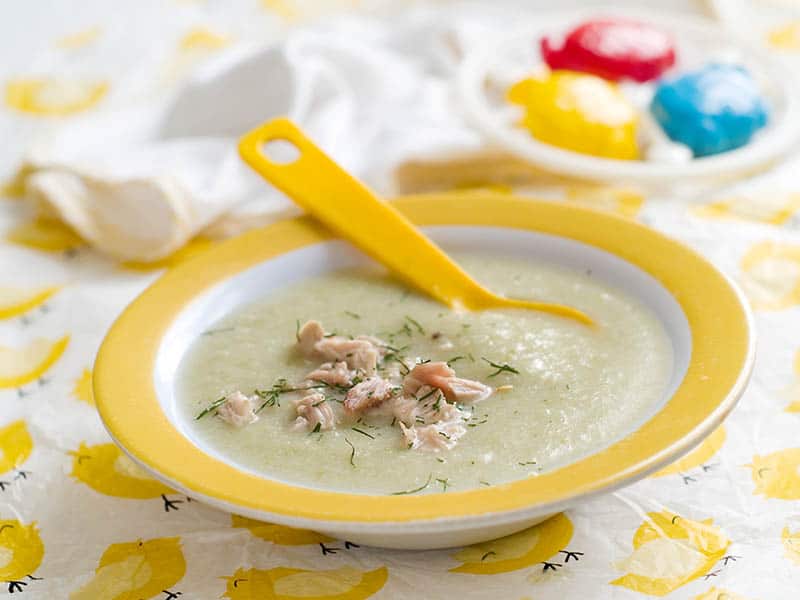
I tried to keep them as straightforward as possible (I know that not every mom has the time or desire to spend hours in the kitchen) but you can even try making casseroles for your baby as she gets older.
Veggies and Chicken Breast
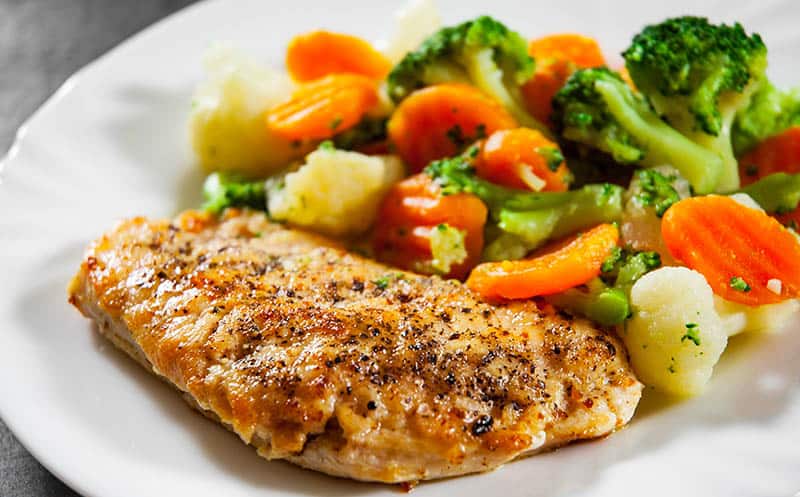
For this recipe, you will need:
- 1 boneless and skinless chicken breast
- 1 carrot, peeled and chopped
- a handful of broccoli florets
For your first step, you’re going to cut up the chicken.
Then, grab a measuring cup and measure a quarter cup of chicken and a quarter cup of broccoli.
Any leftover chicken can be portioned up and placed in the freezer for future use.
Place all of the ingredients in a saucepan and pour just enough water to cover them. Cook meat and vegetables over medium heat until they’re fully cooked, then strain any extra water.
Using a food processor, blend the ingredients and voila – your chicken puree is ready!
RELATED:5 Things To Do When Your Toddler Won’t Eat Meat
Pork with Veggies
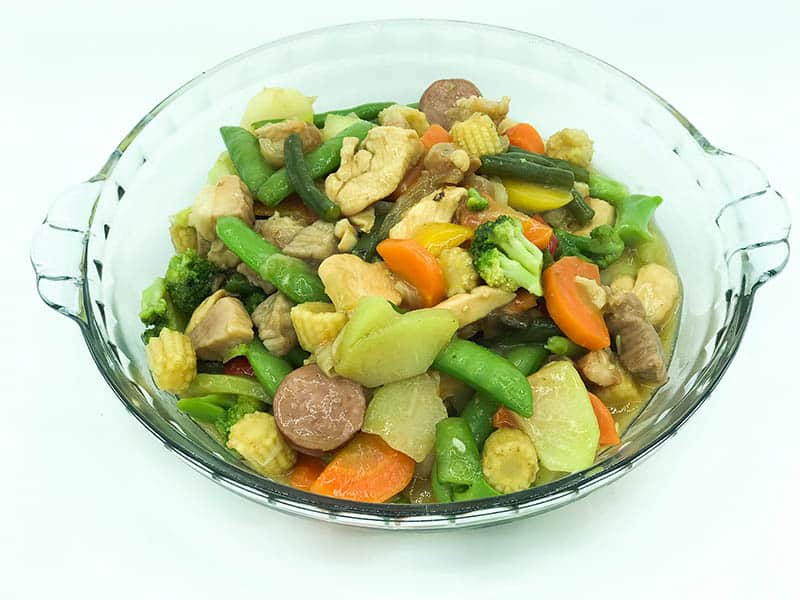
When choosing pork, though, go for meat cuts that contain as little fat as possible.
For this recipe, you will need:
- 2/3 cup pork, diced into small pieces
- 2/3 cup carrot, peeled and chopped
- 2/3 cup potato, peeled and diced
- 1/2 cup green beans, chopped
Pour a little more than a cup of water into a saucepan and add the pork, carrot, and potato.
Once the water is boiling, switch the heat to medium and let it cook for another 20 minutes, adding water if necessary and stirring.
After the 20 minutes are up, throw the green beans in and cook for another 10 minutes. Then, drain the water, mash all the ingredients together, and you’re all set!
Beef baby puree
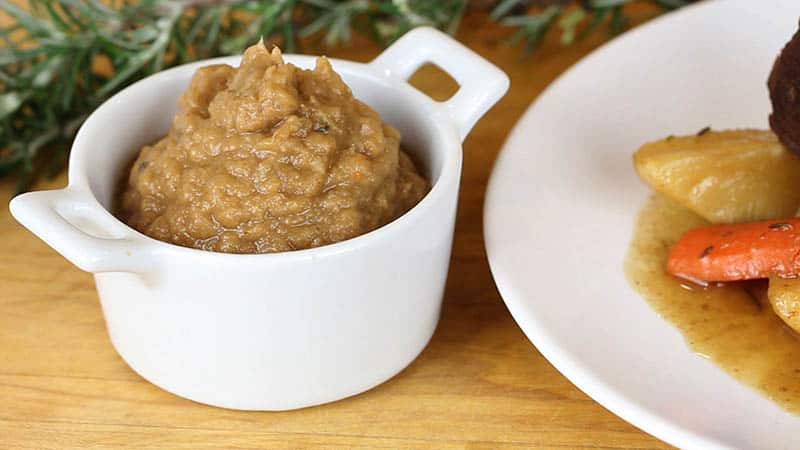
You will need:
- 8-ounce beef steak (sirloin recommended)
- 2 cups water or beef broth
- 1 large sweet potato
First, dice the beef, and peel and cut up the sweet potato (the smaller the cubes are, the better).
Place the ingredients in a saucepan, then add the broth.
Turn the heat on medium and wait until the broth begins to boil, at which point lower the heat and continue cooking for another half-hour.
After the meat and potatoes are thoroughly cooked, use a food processor to blend them (including the broth) into a delicious puree.
Turkey puree
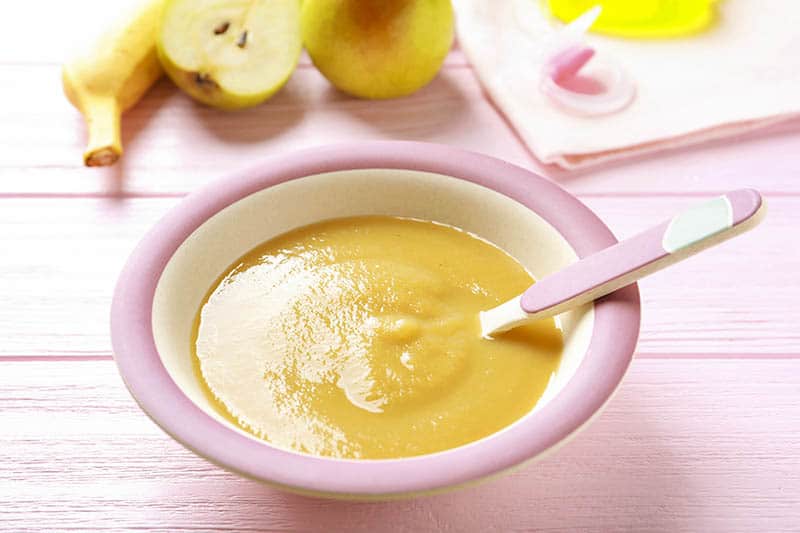
For this recipe, you will need turkey breast (boneless and skinless) that you will cook in some water in a saucepan.
You can also add vegetables such as carrots or broccoli if you like.
When the turkey is cooked and has cooled, cut it up into small pieces and put it in a food processor to puree.
Add water until the consistency is to your (or your little one’s) taste and you’re all done!
Why homemade meat baby food is better than store-bought
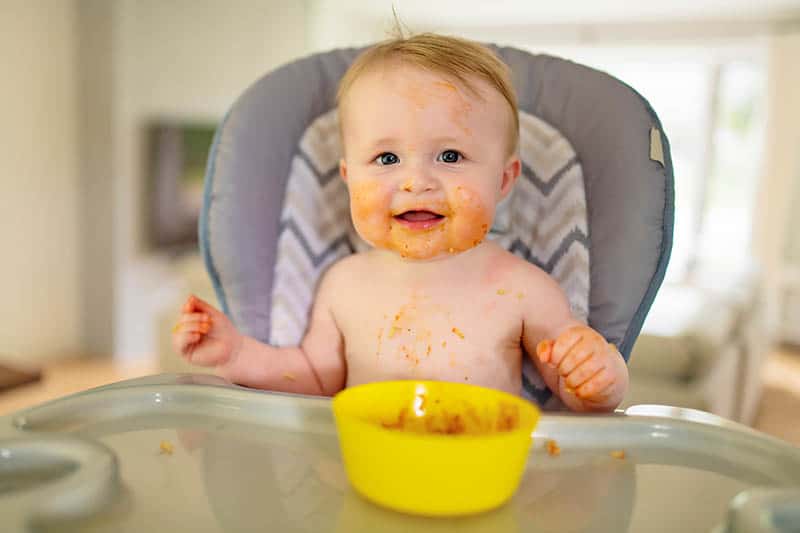
This is certainly not the end of the world, but it shouldn’t become a habit either.
The World Health Organization (WHO) published warnings in 2019 regarding the high levels of sugar found in different foods for babies – and not just pureed fruit meals.
In fact, WHO discovered that even meat baby food contained very high levels of sugar – something many parents wouldn’t expect in a savory meal.
Such high sugar levels can damage babies’ teeth when they first come in and cause children to prefer sweet foods over savory ones.
Not to mention that it opens doors towards developing diabetes in the future, or having trouble with weight.
That’s why I recommend making as much of your baby’s food at home as possible.
From applesauce to bolognese, you can bet there’s a recipe somewhere on the internet for it!
And with homemade baby meals, you get to control what goes in and what stays out, allowing your child to eat healthy food and have a better life.
Why meat is good for babies
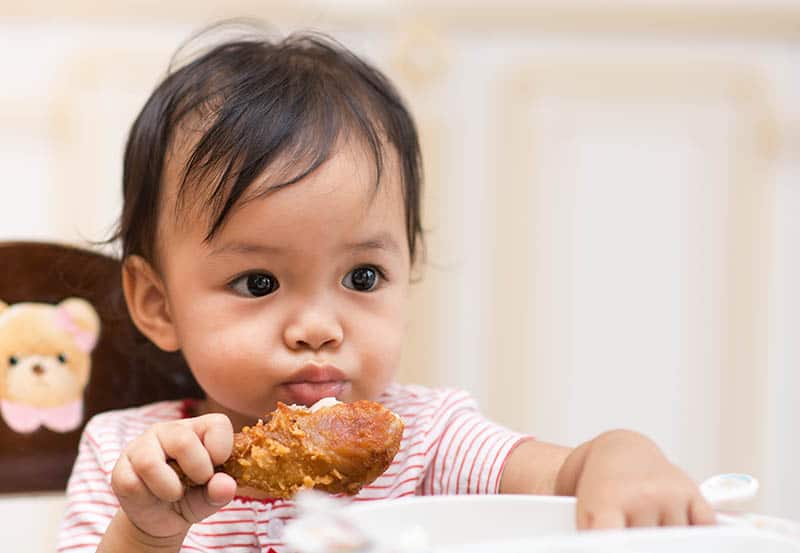
But no, feeding meat to your baby doesn’t involve any questionable pink chicken paste and can contribute greatly to their nutrition and overall development.
Because meat contains plenty of iron, it’s an excellent addition to your baby’s diet.
Before the 6-month mark, iron is not as important in babies’ diet because they store up on iron while they’re in utero.
After half a year, however, the iron starts to run low, making it necessary to add iron-rich foods into their diet.
In addition, it’s a source of zinc, which plays an important role in developing a healthy immune system that can ward off infections and viruses.
Of course, a diet that includes meat ensures that your baby is getting enough protein to stay on track with her growth and development.
Apart from red meat and poultry, you can make meat purees with fish, too.
I should mention, though, that not all fish is suitable for babies, so always double-check whether it’s okay to put it in your baby food puree.
Fish is an excellent source of omega-3 fatty acids, which are responsible for the development of eyes, brain, and nerves.
It doesn’t hurt that it’s delicious, too!
That said, it can be a bit trickier to prepare because you have to make sure it doesn’t contain any bones.
While the American Academy of Pediatrics does say that a plant-based or vegetarian diet is possible for kids, it’s necessary to talk to your doctor about the kind of foods you should introduce to your child to make sure she grows and develops healthily.
Meats to avoid
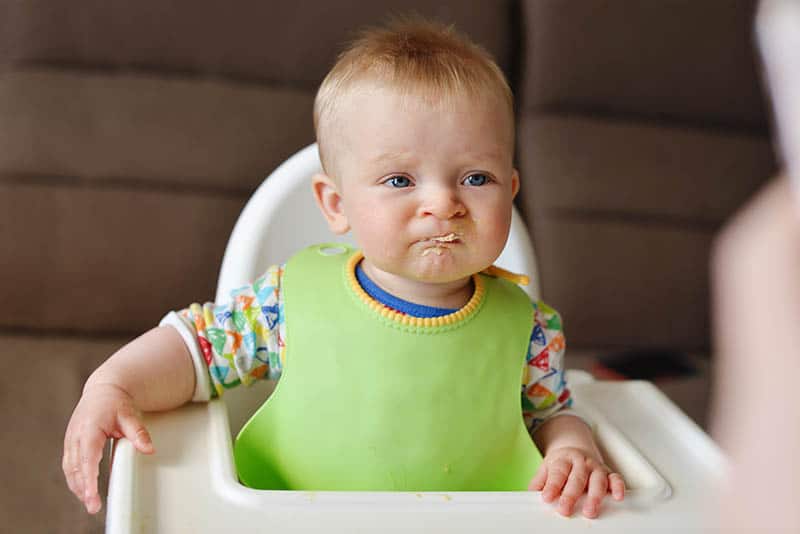
This includes lunch meats such as salami, bologna, bacon, and sausage.
Even though these meats are perfect for sandwiches and many grown-ups eat them on a daily basis, they can contain certain additives that should not be given to infants.
Besides, they are usually very high in sodium, another ingredient that should be avoided when making meat baby food.
Even if you are using a beef or chicken broth to cook the ingredients in, make sure that it’s low in sodium, or doesn’t contain any at all.
Hot dogs should also be avoided whenever possible, especially because they’re not very nutritious and even pose a choking hazard.
If they are given to a child under the age of four, the hot dog should be cut along its length and width into small pieces that aren’t perfectly round.
There are also certain fish that have very high levels of mercury, such as fresh tuna, shark, and mackerel, and shouldn’t be given to a child as they can have a harmful effect on their nervous system.
Solid food tips
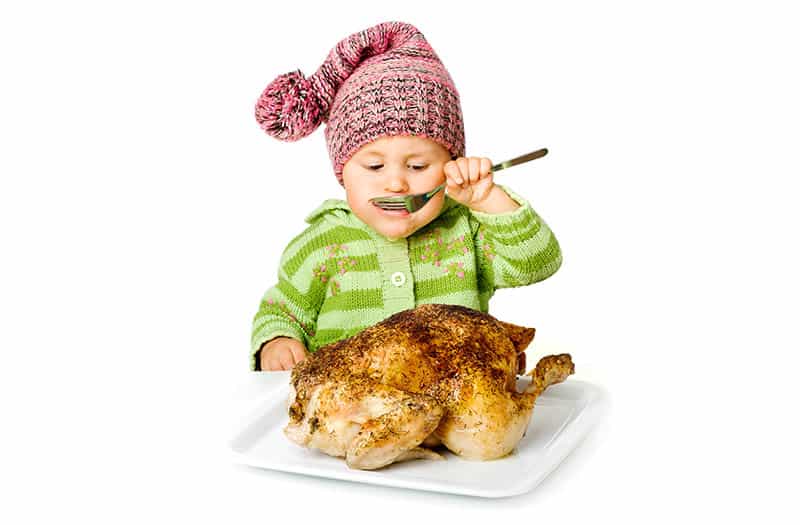
- Accept that your baby is probably going to be very picky, so don’t turn feeding times into a battle. As her first birthday approaches, her appetite will get smaller and she might become even pickier with her food.
- Experts recommend using infant rice cereal to start your baby’s solid food journey, then incorporating vegetables, fruit, and meat, in this order.
- No matter how messy it can get, always use a spoon to feed your little one.
- Fruit juices should not be given to babies under 12 months, as they contain far too much sugar. Afterward, if you do decide to give juice to your baby, opt for brands that don’t contain any added sugar and you can even mix it with water.
- Be open to the kinds of food you give to your baby and don’t only feed her the fruit, vegetables, and meat that you like. For example, if you don’t like fish, that doesn’t mean your little one shouldn’t try fish either.
- Honey and Honey Nut Cheerios should not be given to children under the age of 1 because it can cause infant botulism.
- If your baby plays with her food, it’s not the end of the world! Big kid food is a very new concept, so it’s normal for her to want to play with it.
- Don’t wait until the last minute to feed your baby – by this point, she might already be too cranky and could reject whatever gourmet meal you have prepared for her.
To wrap up
No matter what your personal dietary preferences are, you should explore the possibility of incorporating meat baby food into your little one’s diet.
With a wealth of nutrients, meat is extremely beneficial to infants, but it’s also important to avoid certain meats such as bacon and salami – they’ll have plenty of time to eat this kind of food when they’re older.
Whether they end up preferring chicken, beef, turkey, or fish, healthy meals containing meat will help them continue to grow, and sooner or later, your munchkin will be joining you at the table with her very own plate!
References:
- “WHO/Europe studies find baby foods are high in sugar and inappropriately marketed for babies” published by World Health Organization Europe on the World Health Organization Europe website on July 15, 2019.
- “Plant-Based Diets: Are They Good for Kids?” by Lisa Patel, MD, FAAP and Amanda Millstein, MD, FAAP, published on the Healthy Children website on June 2, 2020.
READ NEXT:
- Best Baby Led Weaning Foods And All You Need To Know About BLW
- Easy Traditional And Gluten-Free Soda Bread Recipe
- What Is Feeding Therapy For Children And How Does It Work?
Like this post? Please share or pin it for later. You can also stay in the loop and follow us on Facebook, Instagram or Pinterest.

This post contains affiliate links. Please see our full disclosure for more info.

